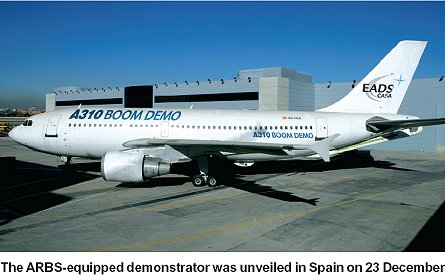EADS has moved a step closer to launching flight trials of the advanced refuelling boom system (ARBS) that provides the cornerstone of its five-aircraft tanker programme for Australia and also forms the basis of a proposal to replace some of the US Air Force’s Boeing 707-based KC-135s.

The first aircraft to be equipped with the new boom – an EADS-owned Airbus A310 – was rolled out from the company’s Getafe plant near Madrid, Spain on 23 December.
The aircraft will soon begin a qualification campaign expected to total 300-400 flight hours. EADS’s Military Transport Aircraft division, which had planned to fly the demonstrator for the first time in mid-2005, says schedule delays have been caused not by “major incidences, but by normal ones derived from a programme of this complexity”.
The development of the ARBS, which includes a boom mast weighing around 1,200kg (2,650lb), with a length extended by 17.8m (58.4ft), represents a $90 million investment by EADS, which launched the project in the hope of breaking Boeing’s near monopoly on the global in-flight refuelling market.
The European company has already secured its first boom-equipped tanker order, with the Royal Australian Air Force to receive five Airbus A330-200s. Airbus is scheduled to deliver the RAAF’s first green aircraft to EADS Casa for modification in May 2006, with the service to complete acceptance testing and declare the type in service with the receipt of two aircraft by late 2009.
EADS North America and Northrop Grumman are also offering an A330-based aircraft, dubbed the KC-30, to meet the USAF’s delayed requirement for new tanker-transports, which is also to be contested by the Boeing KC-767 already selected by Italy and Japan.
Previously leased by Airbus to Madrid-headquarted airline Air Plus Comet, EADS’s A310 demonstrator underwent structural conversion in Getafe from early last year. This included the reinforcement of fuselage sections 18 and 19 to accommodate frames and stringers for the boom mast and its hoist mechanism. The aircraft has also been equipped with a cockpit-located boom operator station, under-fuselage stereoscopic and panoramic cameras, illuminators and approach lights.
CRAIG HOYLE/LONDON
Source: Flight International























